Besançon to Villars-Saint-Georges
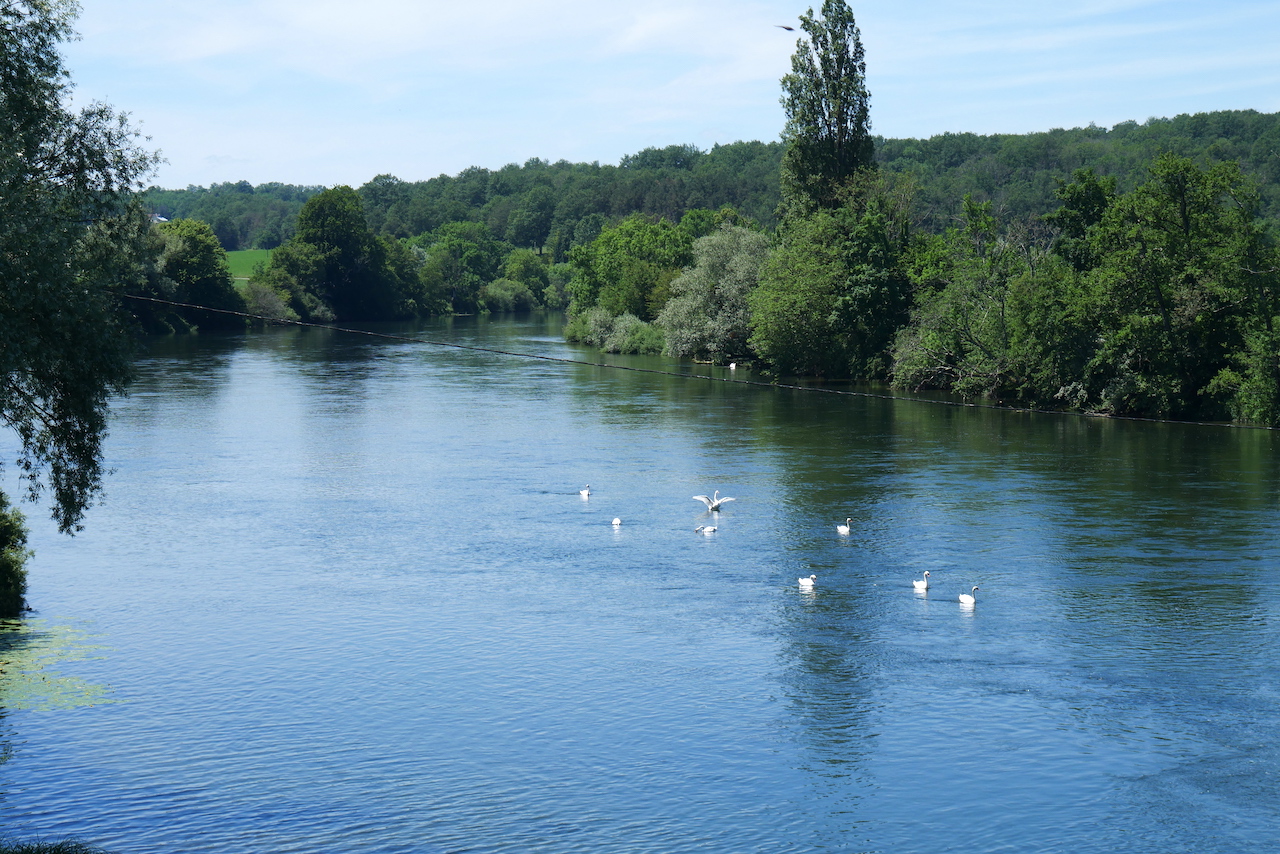
Bourgogne-Franche-Comté
6. Besançon to Villars-Saint-Georges
Difficult
7h30
29,1km
+745m
-742m
Step
Embed this item to access it offline
The Doubs guides you at the beginning of the stage to leave Besançon and then cross the suburbs close to the Comtoise city. The first ascent is to reach the chapel of Notre-Dame du Mont followed by the descent to Boussières then Abbans-Dessous and arrive in Villars-Saint-Georges.
8 points of interest
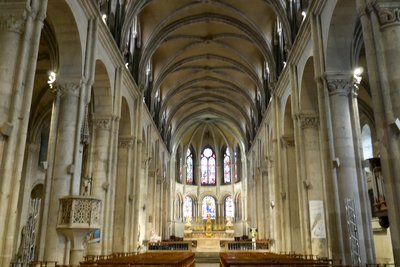
La nef de la cathédrale Saint-Jean de Besançon - Amis saint Colomban TouristSaint-Jean de Besançon Cathedral
The cathedral brings together several periods from the 12th to the 19th century. In the Romanesque period, the nave, the aisles and the lower floor of the choir, facing west, were built. Built between 1127 and 1161, the cathedral is similar to buildings in Moselle and Lorraine and is based on the plan of a Carolingian building, with two opposing apses, erected on the same site in the 9th century. Following a fire in 1212, the nave and aisles were vaulted and the choir part was rebuilt as well as a new bell tower. In 1724, the bell tower collapsed, damaging the centre of the choir which was rebuilt as a bubble bell tower covered with glazed tiles, typical of Franche-Comté.
More information: Wikipedia
La Porte Noire à Besançon, IIe siècle - Amis saint Colomban St ColumbanThe Black Door and the Square Castan in Besançon
The Black Gate of Besançon is a Gallo-Roman triumphal arch of 16.56 m (buried 1 m by the levelling of time) built under the Roman emperor Marcus Aurelius in the 2nd century.
The gate was originally entirely covered with fine and very beautiful decorations on the theme of divinities and mythological battle scenes of gods and heroes to which were added historical scenes representing the Roman army. Unfortunately, these reliefs have been greatly erased by the corrosion of time, the age of the gate (1,800 years), the numerous fires and the fragility of the stone used.
Saint-Colomban was the prisoner in Besançon of King Thierry II, before his expulsion from Luxeuil in 610. He probably passed through this door before escaping with the prisoners as recounted in the Life of Saint Colomban written around 640.
Over the centuries it was integrated into the town's ramparts.
Castan Square is a large, unidentified, semi-circular complex that probably dates back to the 2nd or 3rd century, at the time of the ancient Gallo-Roman city of Vesontio. It was not until 1870 that the town's archaeologist and librarian, Auguste Castan, began excavations there. He discovered eight Corinthian columns that were brought up, the remains of the water distribution basin of the Arcier aqueduct.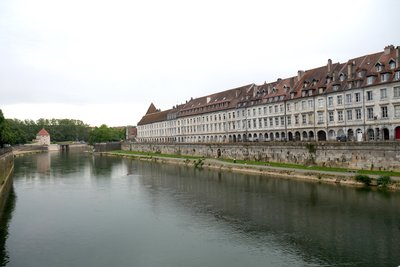
Le quai Vauban en amont du Doubs - Amis saint Colomban TouristThe quays of the Doubs in Besançon
Stroll along the banks of the Doubs to discover this harmonious string of houses with arcades.
Although it is contemporary to him, the Quai Vauban owes nothing to the military architect other than its name. It was built from 1691 to 16953 by the engineer Isaac Robelin assisted by his brother.
The quay replaces two old ones located upstream from the Battant bridge and the two others downstream...
Built on a 600-metre-long raised escarpment, it is bordered, on the town centre side, by an alignment of buildings built in Chailluz stone and whose ground floor is equipped with arcades. These buildings were built against the very advice of Vauban who wanted the continuity of the urban enclosure although this section is protected by the Battant bridgehead.
Due to a lack of financial means, the whole is not entirely realized as initially planned.
During this walk you will meet the illustrious figures of Besançon such as Victor Hugo and the Lumière brothers, a native of the city. But also the Marquis Jouffroy d'Abban, inventor of the steamboat whose first tests were carried out on the Doubs at Baume-les-Dames. His relative the Abbess of Baume-les-Dames had financed the operation.
Façade du palais Granvelle - jacques.prudhon HistoricalThe Granvelle Palace in Besançon
The Granvelle palace is a 16th century Renaissance palace in Besançon. It was built by Nicolas Perrenot de Granvelle, a wealthy keeper of the seals, first counsellor and ambassador of Charles V, Germanic emperor and suzerain of the County. Built from 1532 in the heart of a plot of land of exceptional dimensions for the time. It refers to the new architectural trend born in Italy during the 15th century: the Renaissance. It was a prosperous period for architecture in Besançon and more generally in Franche-Comté as in Luxeuil.
In the 1990s the city of Besançon undertook restoration work. Since 2002, the Granvelle palace has been home to the Musée de Temps, a tribute to the city of Besançon: the French capital of watchmaking.
L’église Saint-Etienne de Boussières - Amis saint Colomban TouristThe church of Saint-Etienne de Boussières
The church of Boussières is one of the rare testimonies in Franche-Comté of the first Romanesque age. The entrance porch is original and its typical Comtois bell tower, covered with polychrome tiles in the 19th century, makes it very charming. It dates from the second half of the 11th century and is classified as a historical monument.
Over the centuries this agricultural village where the cultivation of cereals, vines and the breeding of animals with or without horns, is favoured by a fertile soil.
In the 19th century, stone quarries were exploited for the construction of the Rhine-Rhone canal. The driving force of the Doubs was exploited in the 19th century by the construction of a paper mill created by an exiled Alsatian after the war of 1870. This is how the Zuber-Rieder de Boussières paper mill was born.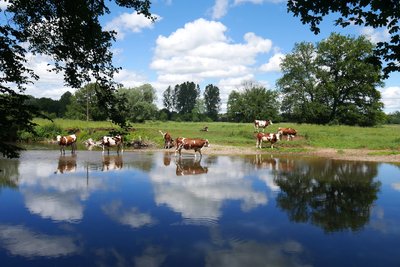
Les Vaches aiment l’eau - Amis saint Colomban CulturalCows of the Montbéliard breed in Franche-Comté
Since your departure from Luxeuil-les-Bains you have encountered meadows where mostly white and red spotted cows graze. The pictures have been taken on the Via Columbani since you left Luxeuil-les-Bains.
The Montbéliarde is a French cattle breed resulting from the crossbreeding of breeds from Switzerland and native Franche-Comté between the 18th and 19th centuries.
It is a mixed breed: it is an excellent dairy for making cheese, the first dairy in the French Protected Designation of Origin, and jointly produces quality meat. Its place in cattle breeding in France has been growing steadily since the 1950s.
Plus d’informations : Wikipédia
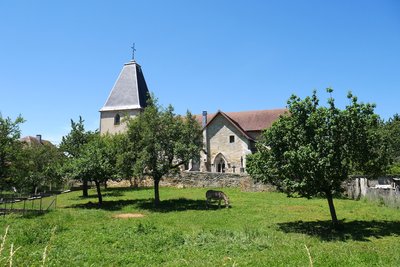
L’église de l’Assomption à Jouffroy-d’Abbans - Amis saint Colomban HistoricalAbbans-Dessous
One cannot dissociate the history of Abbans-Dessous, formerly called Abbans-la-Ville, from that of Abbans-Dessus, named Abbans-le-Château.
As early as the 12th century the name of the village of Abbans-Dessous is attested.
In 1370, Abbans-la-Ville came by marriage into the de Joux family. In the following century, Anne, daughter of Jacques de Joux, lord of Abbans, married Jacques Jouffroy, lord of Marchaux. After Anne's death, in 1511, Jacques Jouffroy married Béatrice Merceret, from Salins: from this union came the Jouffroy d'Abbans, lords of Château-Derrière and Abbans-la-Ville.
At 1 kilometre from the village, the priory of Lieu-Dieu, whose chapel remains, is the burial place of the Jouffroy d'Abbans family.
Église de Villard Saint-Georges - Amis de saint Colomban TouristSaint-Georges Church in Villars Saint-Georges
In the 13th century the land of Villars Saint-Georges belonged to Guillaume d'Abbans according to the writings it is about forty people who populate the village. A long time later, in 1583, an important change took place: the estate became a seigneury. Thomas de Jouffroy, lord of Abbans, is at the same time lord of Villars Saint Georges. His descendants kept the fief until 1742, when they sold it to Etienne Pourcy, magistrate. The latter sold it shortly afterwards, in 1763, to Charles-Frédéric Arbilleur, lawyer at the Parliament, descendant of an old bisontine family.
It is difficult to date the construction of the church.
The village offers a gîte next to the church.
Description
Leave the Saint-Jean Cathedral, go down rue de la Convention, at the Palais Granvelle on the left, rue de la Préfecture, at the crossroads rue Charles Nodier on the right, on the left Boulevard Charles-de-Gaulle, cross the Doubs.
- After the bridge on the left, take the road along the bank of the Doubs, quai Henri Bugnet, chemin Mazagran. In Velotte take the bridge over the Doubs, on the right after the bridge over the bank of the Doubs, chemin de halage de Casamene. At Poussot turn left and right on rue du Stade, stay on the towpath.
- In Aveney, rue de Beure, rue de la pompe to the right and to the left, rue René Paillard, stay on your right, rue des Vergers to follow the Rhone-Rhine canal. After the junction of the canal with the Doubs, continue on the bank of the Doubs.
- Beginning of the Doubs bypass canal, after the lock, on the left, path in the woods towards the Notre-Dame du Mont chapel, stay on your right to go up.
- Go down by the path in front of the chapel, on the right turn left, in front of the rubbish dump, on the left, chemin de la Planche Ronde, rue de l'Eglise on the left, route de Quingey, second street on the left, chemin du Bas des Vignes, on the right, chemin du Vigney, straight ahead in the woods on the right, crossroads D107 on the left, crossroads D466 on the right.
- Abbans-Dessous, straight through the village, left in front of the railway, right tunnel under the railway, stay on the main road along the Doubs, cross the D13, take the D400 and stay on the Doubs.
- Crossroads D408, straight ahead on a dirt road stay on your left, on the right crossroads D408, Villars Saint-Georges at the fork on the left, you arrive at the church and the communal lodging.
- Departure : Saint-Jean Cathedral, 10 rue de la Convention, 25 000 Besançon
- Arrival : St. George's Church, 1 rue de l’Église, 25 410 Villars-Saint-Georges
- Towns crossed : Bourgogne-Franche-Comté
Altimetric profile
Report a problem or an error
If you have found an error on this page or if you have noticed any problems during your hike, please report them to us here:
Close by6
- Accommodation






